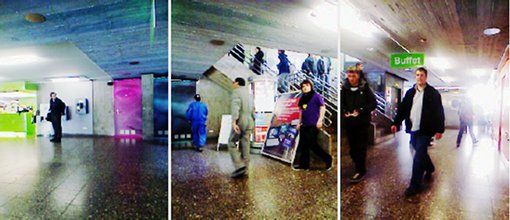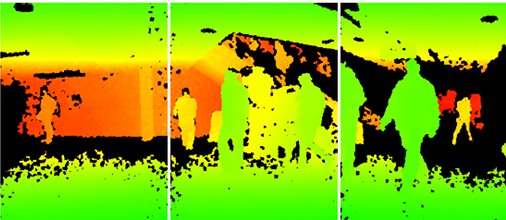Inicio » kinect
Archivos de la categoría: kinect
New Kinect sensor
…we don’t have any actual specs on the new Kinect yet. Most of the details that we’ve got are from various (brief) hands-on demos, but here’s a rundown of the new stuff:
- “High-definition,” “high-fidelity” 3D vision. Obviously, the biggest deal for robotics is the improved 3D sensing. We’re not sure what “high-definition” means, exactly, but it’s definitely better, possibly 1080p 60fps better. The sensor itself operates based on time of flight (like a radar gun), making it at least three times more sensitive and lighting-independent. It can see the freakin’ buttons on your shirt from several feet away! This means better object recognition, better mapping, better everything that you depend on 3D data for.
- Active IR. Kinect can now see in the dark. IN THE DARK, PEOPLE!
- Skeletal tracking with joint rotation. When combined with a physics model, the sensor can estimate muscle movements and forces.
- Pulse detection (!). The sensor tracks color changes in your skin to determine your heartbeat.
- Emotion detection. In addition to tracking binary things like eyes and mouth open or close, Kinect also estimates your emotional state and whether or not you’re paying attention to it.
A pretty amazing video demo from Wired:
Kinect interfaces
Microsoft interface
Microsoft released Kinect software development kit for Windows 7 on June 16, 2011. This SDK will allow developers to write Kinecting apps in C++/CLI, C#, orVisual Basic .NET. The main features are:
- Raw sensor streams: Access to low-level streams from the depth sensor, color camera sensor, and four-element microphone array.
- Skeletal tracking: The capability to track the skeleton image of one or two people moving within the Kinect field of view for gesture-driven applications.
- Advanced audio capabilities: Audio processing capabilities include sophisticated acoustic noise suppression and echo cancellation, beam formation to identify the current sound source, and integration with the Windows speech recognition API.
- Sample code and Documentation.
In March 2012, Microsoft announced the next version Kinect for Windows 1.5. It adds the following features:
- The Kinect for Windows 1.5 SDK woud include ‘Kinect Studio’ a new app that allows developers to record, playback, and debug clips of users interacting with applications.
- Support for new “seated” or “10-joint” skeletal system that will let apps track the head, neck, and arms of a Kinect user – whether they’re sitting down or standing; which would work in default and near mode.
- Support for four new languages for speech recognition – French, Spanish, Italian, and Japanese. Additionally it would add support for regional dialects of these languages along with English.
- It would be available in Hong Kong, South Korea, and Taiwan in May and Austria, Belgium, Brazil, Denmark, Finland, India, the Netherlands, Norway, Portugal, Russia, Saudi Arabia, Singapore, South Africa, Sweden, Switzerland and the United Arab Emirates in June.
OpenNI interface
The OpenNI framework provides a set of open source APIs. These APIs are intended to become a standard for applications to access natural interaction devices. The API framework itself is also sometimes referred to by the name OpenNI. The APIs provide support for:
- Voice and voice command recognition
- Hand gestures
- Body Motion Tracking
Wrappers for Matlab
- C++ wrapper for for the Microsoft Kinect and OpenNI libary [Link1][Link2 (private)]
LIRIS human activities dataset with depth data
This dataset had been originally shot for the ICPR 2012 human activities recognition and localization challenge (ICPR HARL). Target applications are the recognition of complex human activities, focusing on complex human behavior involving several people in the video at the same time, on actions involving several
interacting people and on human-object interactions.The dataset has been shot with two different cameras:
- a moving camera mounted on a mobile robot delivering grayscale videos in VGA resolution and depth images from a consumer depth camera (Primesense/MS Kinect); – a consumer camcorder delivering color videos in DVD resolution.
- The dataset comes with full annotation and several tools and consistsof the following parts:
- Video data (rgb, grayscale and depth frames).
- XML annotations of the activity bounding boxes.
- Calibration data and software for the MS Kinect depth sensor used during acquisition.
- Software for browsing videos and annotations (superimposed rectangles) and also for the creation of new annotations
- Software for evaluating new recognition software : automatic creation of precision/recall curves and integration of localization information into the evaluation process.
The dataset is centered on the following action classes:
- Discussion of two or several people.
- A person gives an item to a second person.
- An item is picked up or put down.
- A person enters or leaves an room.
- A person tries to enter a room unsuccessfully.
- A person unlocks a room and then enters it.
- A person leaves baggage unattended (drop and leave).
- Handshaking of two people.
- A person types on a keyboard.
- A person talks on a telephone.
The next Kinect-like product for short ranges
Watch carefully the next video to enjoy the great possibilities that this sensor can have for Computer Vision.
Kinect datasets
-
List
- RGB-D Person Re-identification Dataset [Link]
- Oriented to person re-identification using depth information.
- Matlab script for interfacing the dataset.
- RGB-D People Dataset. [Link]
- Ground truth.
- Suitable for video tracking.
- Contain RGB and depth images acquired from different Kinect sensors simultaneously.
- NYU Depth Dataset. [Link]
- Ground truth.
- Segmentation oriented.
- Matlab code for interfacing it.
- RGB-D Object Dataset. [Link]
- Segmentation oriented.
- Biwi Kinect Head Pose Database. [Link]
- Ground truth.
- Head pose.
- IROS 2011 Paper Kinect Dataset. [Link]
- Ground truth.
- Camera calibration, scene reconstruction.
- RGB-D SLAM Dataset and Benchmark. [Link]
- Ground truth.
- Visual odometry and visual SLAM.
- Kinect (RGB+D) dataset by the CVPR team at Technische Universitat Munchen. [Link]
- Ground truth.
- Visual odometry and visual SLAM.
Visual samples

RGB-D Person Re-identification Dataset 
RGB-D People Dataset -

RGB-D People Dataset

